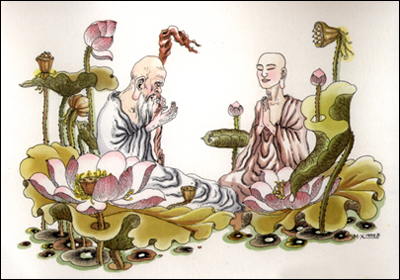
| Contents
60.2 Eight Negations of Middle Way 60.3 Fifty-two Positions in the Process of Cultivation
60.3.2 Ten Dwelling 60.3.3 Ten Behavioral Activities 60.3.4 Ten Transferences 60.3.5 Ten Stages 60.5 Basic Doctrine
All Buddhist teachings are induced by the Double Truths, i.e. Real Truth [真諦] and Common Truth [俗諦]. The Real Truth, i.e. Paramartha-satya in Sanskrit, refers to the correct dogma of the Real Mark of Middle Way, which is beyond words and perception by human beings. The Common Truth, i.e. Samvrti-satya in Sanskrit, refers to the expedient teachings as if all phenomena are real. The two forms of statements in the Buddhist teaching are complimentary to each other. If the Buddha teaches us the Real Truth only, ordinary people cannot interpret all the phenomena which are then believed to be discrete and extinct. If the Buddha teaches the Common Truth only, they do not understand thoroughly the ultimate principle of tranquility of self nature and thus unable to be liberated completely and salvaged. The teaching was refined by Chih-tsang (549-623 AD) in his commentaries 'The Essay on the Double Truth'. 60.2 Eight Negations of Middle Way [八不中道] Based on the Middle Way teaching, Nagarjuna sought to promote the perfect wisdom of 'absolute emptiness' by negating all views, which can be summarized by Eight Negations, i.e.
60.3 Fifty-two Positions in the Process of Cultivation This sect adopted the fifty-two positions of Bodhisattva in the process of his cultivation, as stipulated in the Commentary of Mahaprajna Paramitas.
The ten grades of Bodhisattva's faith, which are also the first ten progressive stages in the 52 Bodhisattva's positions in cultivation. All false view are subdued by Ten Faith. They are:
The ten stages in Bodhisattva wisdom, which are the second ten stages in the 52 Bodhisattva's positions in cultivation. Subsequent to the cultivation of the Ten Faith, the practitioner will enter the stream of sages. All false views on dwelling are cut off and all desires are subdued by Ten Dwellings. They are:
60.3.3 Ten Behavioral Activities [十行] The ten behavioral activities of Bodhisattvas done for the benefits of others, which is the third ten stages in the 52 Bodhisattva's positions in cultivation. All matters related to material and love are subdued. They are:
60.3.4 Ten Transferences [十迴向] The fourth ten stages of the 52 Bodhisattva's positions in cultivation. All existence and love are subdued by Ten Transferences. They are:
The ten stages of the development of a Bodhisattva into a Buddha, which are the fifth ten of the 52 Bodhisattva's positions in cultivation. According to 'The Commentary on Mahaprajna Paramita' [大智度論], the ten stages are:
Each of the ten stages is connected and related to each of the Ten Paramitas practiced by Bodhisattvas. The ten major ignorances are also cut off, corresponding to the Ten Stages. The sect was important because it elaborated the original concept of emptiness (i.e. Sunyata in Sanskrit) in Buddhism. Emptiness is one of the basic theory of all sects in Mahayana Buddhism. However, this sect opposed the rigid classification of existence [假] and emptiness [空], and denies the two extremes of creation and extinction, etc in the interests of Middle Way [中]. The characteristic of this sect was dissolution of every proposition into thesis and anti-thesis. The refuting of both emphasized the interest of the third, i.e. the doctrine of Middle Way. Similar concept was also adopted by Tien-tai [天台] Sect, which will be discussed later. (Painting by Mi Hsiung)
|
 These
positions were established in accordance with the teaching of the
Common Truth. They are: Ten Faith, Ten Dwelling, Ten Behavioral
Activities, Ten Transference, Ten Stages, and Samyaksambodhi (Absolute
Universal Enlightenment) as the 51st , and lastly the
Wonderful Enlightenment, which is actually the position of Buddhahood.
These
positions were established in accordance with the teaching of the
Common Truth. They are: Ten Faith, Ten Dwelling, Ten Behavioral
Activities, Ten Transference, Ten Stages, and Samyaksambodhi (Absolute
Universal Enlightenment) as the 51st , and lastly the
Wonderful Enlightenment, which is actually the position of Buddhahood.

